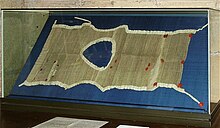Silicon
Cilicium is the name for a coarse material or a hair shirt that was worn directly on the skin under clothing for ascetic reasons or for penance. The name is derived from the region of origin Cilicia in Anatolia. There, tents and tarpaulins were made from goat hair, but also items of clothing.
The first recorded use of the scriptures found in the Vulgate , Psalm 35 (34): Ego autem, cum mihi Molesti essent, induebar cilicio ( Ps 34:13 VUL , "but I put on a penitential garment when they were annoying me ... ... "). In the books of kings it is reported that King Ahab and Ben-Hadad, king of Aram, wore a robe of penance on their bare skin ( 1 Kings 21.27 EU , 2 Kings 6.30 EU ). From the Hebrew word שק ( saq ) and its Latin translation saccus , the phrase “to go into sackcloth and ashes” is derived.
In the New Testament , John the Baptist wears a penitent shirt made of camel hair ( Mk 1.6 EU ). From the 4th century onwards, church penitents wore a silicon that mostly consisted of horsehair , pig bristles , but also other materials whose hair feels uncomfortable when worn directly on the skin.
In the course of time, the silicon was worn constantly under the habit of saints and religious as a sign of humility and penance , sometimes also by lay people, secular and ecclesiastical dignitaries, among them the holy. Thomas Becket , Patrick , Karl , Franziskus von Assisi , Therese von Lisieux , Padre Pio , Mother Teresa and Paul VI. , Henry IV. Wore on his journey to Canossa a hair shirt.
Until the reforms in the wake of the Constitution Perfectae caritatis on the contemporary renewal of religious life, the Carthusians wore a penitential shirt made of horse and goat hair under their robes on their chest and back. It is now no longer common for all members to wear a silicon in most communities, although little can be said about the extent of actual use, as it is underwear. Some convents of the Discalced Carmelites , the concept developers and Conceptionist as well as the numerary of Opus Dei , it will continue to use the latter as a metallic cilice, which is placed around the thigh and the hour taken.
literature
- John L. Allen, Opus Dei: An Objective Look Behind the Myths and Reality of the Most Controversial Force in the Catholic Church , Doubleday, 2007.
- Karel C. Innemée: Cilicium . In: Walter Kasper (Ed.): Lexicon for Theology and Church . 3. Edition. tape 2 . Herder, Freiburg im Breisgau 1994, Sp. 1200 f .
